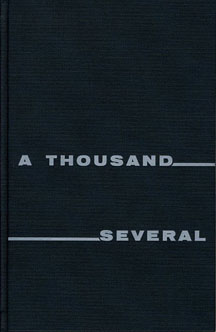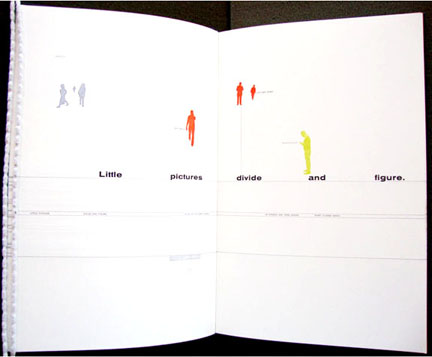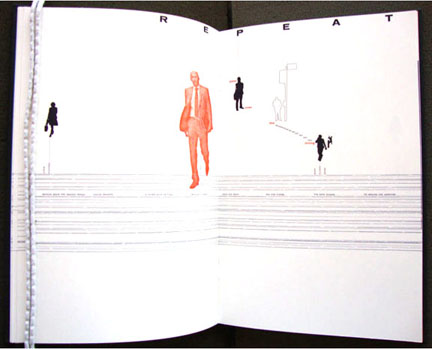Poets in the Print Shop
June 1, 2012, 3:06 pm
By Lisa Russ Spaar
Several years ago a colleague in the studio art department and I team-taught a course we called “The Matrix,” an experiment in bringing together eight advanced printmaking students and eight advanced poets to make new work, including several high and low-end collective books. A matrix, in the printmaking lexicon, refers to the plate—zinc, plate, copper—or other material (stone, collage) used in printing, but when we advertised the course we had a lot of interest from initially thrilled and then bitterly disappointed fans of the 1999 science fiction film of the same name, undergraduates who thought that it was high time that the cinema icon got the serious attention it deserved in the academy.
There was much enthusiasm among the young artists and poets as well, of course. , and our idea as instructors was to throw them (and ourselves) into the water, with the presumption that our disciplines—poetry writing and intaglio printmaking—were distinct enough to generate fruitful friction and close enough to allow for revelatory and empathetic artistic exchange.
This “throwing into the water” turned out to mean many things, perhaps chief among them the potentially dangerous fact that although half the class had never before set foot in a print shop (described by my art colleague as a “15th-century chemistry lab without the safety features”), we were almost immediately involved in processes using acids and other toxic substances. Most fumes emitted in poetry writing workshops tend to come from the ubiquitous coffee cups and from occasional traces of cigarette smoke brought into the room after breaks; by contrast, we regularly left the print shop with filthy hands and heads high as kites from our unaccustomed breathing in of acetone, inks, resins, and other substances in a myriad of containers marked with skulls and crossbones.
Another learning curve for the poetry students was an initiation into the time commitment involved in the serious pursuit of studio art. The typical advanced poetry workshop meets for three hours once a week; print-making courses meet for two-and-a-quarter hours twice a week. Our particular course was scheduled in the mornings on Tuesdays and Thursdays, commencing at 9:30 a.m.; allowing poetry students to explore their consciousnesses before, say, noon was another gift of the collaboration. And while it is understood that the advanced poetry student commits a lot of out-of-workshop time to musing and writing independently, this activity can be done in coffee shops, bars, subways, or in the privacy of one’s bed or bathroom. Printmaking students also devote many, many hours outside of class to generating and completing projects, but this work must be done predominantly in the print shop. Another ambivalent plus, then, for the poets was the discovery of a new (and there aren’t many) 24/7 venue in Charlottesville.
Despite the fact that the studio art department had been relocated for the two years that we taught “The Matrix” to two ventilated, corrugated metal, temporary outposts while a new, state-of-the-art facility was being built, despite the early hour of our class, despite the time commitment and the extra work (my colleague and I both taught the course as an overload to our regular Departmental course commitments), the matrix experience was intensely rewarding. I found the printmaking students, who were used to experimentation and to thinking on their feet, to be exceptionally open to the making of poems, even though most of them had never attempted poetry writing before. Perhaps because intaglio printmaking is a “negative” art (what one etches shows up in reverse on paper; what’s etched away appears dark, and vice versa), “opposite” exercises (in which students “pull” new poems off of extant ones) yielded exciting new work; similarly, write-in, erasure, and strike-through exercises used techniques familiar to the printers, who were used to staining, gesso-ing, Chine-collé layering, and all manner of obscuring, illumination, and multi-valence. As part of the course, all of the students were engaged in semester-long, serial, “flood-subject” projects, both individual and collaborative. As printmaking is intrinsically serial, this aspect of the course also came naturally to the print-makers.
As the poets and printmakers collaborated over time, the poets became more comfortable with a fresh range of attitudes, vocabularies, processes, and energies. We became less anxious about “ownership” (while poets are sometimes fiercely territorial and proprietary about their productions, printmakers tend to seek ways to creatively sabotage, manipulate, and in other ways sample and become involved with each other’s work) and also more comfortable with foregrounding the processes of our drafts rather than privileging the final product. Often, for example, something marvelous would result from a “mistake” that a student might make along the way—an over-bitten plate, or an aberration caused by burring or over-inking. My colleague would point to the print (and here’s another exciting difference between poetry and printmaking workshops: In poetry classes, the works under discussion are passed around on discrete pieces of paper or viewed on laptop screens, while in the print shop all work on paper is posted vertically, tacked to the wall, for the community to see) and say, “Look, that’s amazing. Now figure out how to do that deliberately.”
We talked a lot, as we worked together, about “the stain” and about defacement, about the line, about the bleed. All of these printmaking phenomena, new to us poets, had exciting parallels and possibilities in poems. Crucially, we learned about and made paper. We also learned to create, stitch, and bind folios. We dyed endpapers, and covered and glued and pressed hardcovers. For one book project, we were privileged to work with a metal artist, who showed us how to use gilt and lapis to emboss a front cover. I doubt that any poet participating in the “Matrix” course now looks at or handles a book without thinking of its materiality and its making. Printmaking discourse also provided the poets with a trove of new words, all, again, with suggestive resonances in poems, as well, terms and phrases such as false bite, bon à tirer, burin, mezzotint, criblé, creeping bite, and retroussage.
Of the many gifts of the printmaking experience for poets in the “Matrix” class, perhaps chief among them was the reminder to writers working primarily in digital media (computer and other virtual type) that writing is, or can be, drawing. And lines drawn by hand, whether etched into a metal plate or scrawled across the blue staves of a Moleskine notebook—forays made into the matrix—possess an inimitable warmth and immediacy of expression and effect. Printmaking reminded us to attend to the ghost, to the mark, of what Keats called our “living hand” in our poetic efforts. The materiality of our techniques was revealed to us anew with each pull of a print, each dip of the plate into its acid bath, opening us up to the crucial connection, in all art, between idea and praxis, and, importantly, to the power of mistake, flaw, and the grace of a hand-made thing.
Lisa Russ Spaar is The Chronicle’s poetry blogger and a professor of English at the University of Virginia.
Chronicle of Higher Education, 6/4/12













